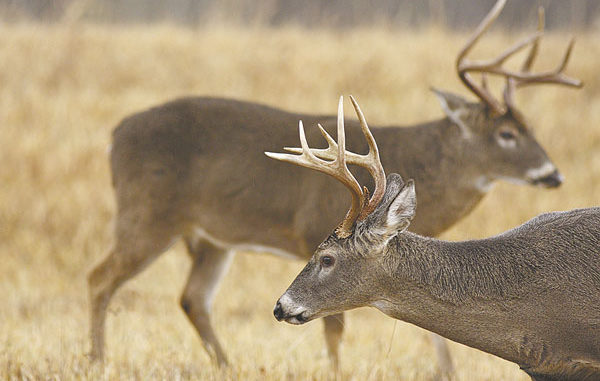
During the rut, young bucks will point the way to the bruisers.
EDITOR’S NOTE: For the next 12 months, renowned wildlife photographer Tommy Kirkland will give readers an inside look into the private world of whitetail deer. The degree of hunting pressure, nutrition, buck-to-doe ratios, management, genetics and weather can influence not just the rut’s timing, but whitetail social interactions as well. Even so, by instinct, rutting bucks usually follow the same behavioral traits — even when immature bucks get in on the action.
When the rut is in full swing, mature bucks are tending and breeding estrous does while young bucks, instinctively desperate to test their testosterone, attempt to spoil the party. If two of them gang up on a tending couple, then a ruckus is under way. Although they will not defeat the dominant buck tending his mate, they may instinctively create a strategy of constant harassment.
In an effort to reach the female, young bucks from 1½ to 2½ years in age can be more than curious during the rut. Though they haven’t fully developed, their actions say otherwise.
Once a female is fully receptive, bucks of all ages may swarm the area. Of course, the degree of action depends on buck-to-doe ratios and population densities at hand. Also, if the majority of females are locked up with mature deer, then bucks could be spread out and preoccupied — making them less visible. However, once peak breeding diminishes, the rut changes again.
Areas that practice QDM will most likely experience a few upcoming males that put mature deer to the test. These younger bucks are by no means able to physically challenge older deer. Yet they can frustrate an older buck’s efforts to successfully breed.
Usually, if it is just one young buck, the mature breeder is able to keep him at bay. As the immature deer tries to get close, scenting the hot doe, the older buck is swift to charge. The young buck retreats, yet may still try to circle around to the couple’s backside. Here again, the mature buck keeps him at bay.
Besides charging and running him back, the mature buck also lets loose with wheeze vocals, foot stomping, bristled fur, sidling and folded ears. Eventually, the young deer moves back and nonchalantly forages nearby — periodically looking up at the breeding pair.
However, if two to three younger bucks team up, trouble is on the way. Although these up-and-coming bucks do not consciously formulate a strategy to invade, each one’s attempt to get to the estrous doe sometimes pans out like a formulated plan of attack.
Simply, as one buck approaches from the front side, another buck moves to the rear side. The larger mature buck, as he attempts to intercept one of the younger bucks, temporarily loses control of tightly tending the female. One of the two young bucks breaks her perimeter — causing the doe to bolt away.
Ultimately a chase is on. As long as the mature buck is in good health, he can catch up and stop the pursuers. However, a carousel is under way, and until the estrous doe stops to takes refuge again, the couple’s rendezvous is disrupted.
Estrous females are usually selective of the buck they permit to breed. This is one of the reasons they try to outmaneuver persistent young bucks. However, younger female deer will occasionally, in all the chaos, allow a young whippersnapper to breed, yet it is usually short lived as soon as the mature buck gets back in on the action.
Some mature bucks are physically agile enough to cut-off the intruders while keeping up with the fleeing female. Of course, the entire ruckus depends on the female and her course of action. The mature buck’s health and persistence, as well as the grit of immature bucks, influence the situation as well.
So what do these diverse social interactions mean for the hunter afield? As many sportsmen can attest, once does and bucks go into cover to breed, things can get pretty frustrating. However, for those properties that practice QDM, allowing the younger bucks to roam can sometimes create a natural “drive” for flushing a hot doe and tending buck into open site.
To a stalking hunter, young bucks hot on a doe can reveal where the mature bucks are locked up during the rut. Typically a dominant buck stays with a doe for 24 to sometimes 48 hours.
Of course, the female’s degree of alertness will affect the outcome. Though not always the case, females in peak estrus can go into a stupor. This causes them to be less cautious of their surroundings. Also, if they have been previously chased by younger bucks and exhaustion sets in, they usually become a little more tolerant to sound and movement — associating it with pushy bucks.
Although there is no rule when it comes to rut behaviors, occasionally opportunities do arise to capitalize on natural events amongst the deer. Here, younger bucks harassing estrous does can expose the mature buck, and if the hunter can remain undetected and get within range, sometimes a harvest unfolds.
All in all, even though the rut is ever-changing, each locale generally has a pattern year after year. Old females typically do breed in the same areas each year if not highly pressured by humans and predators. Assessing this information in combination with breeding times from previous years, buck-to-doe ratios and the number of immature bucks trying to get in on the action, then the described behaviors can certainly work to a hunter’s advantage.



Be the first to comment